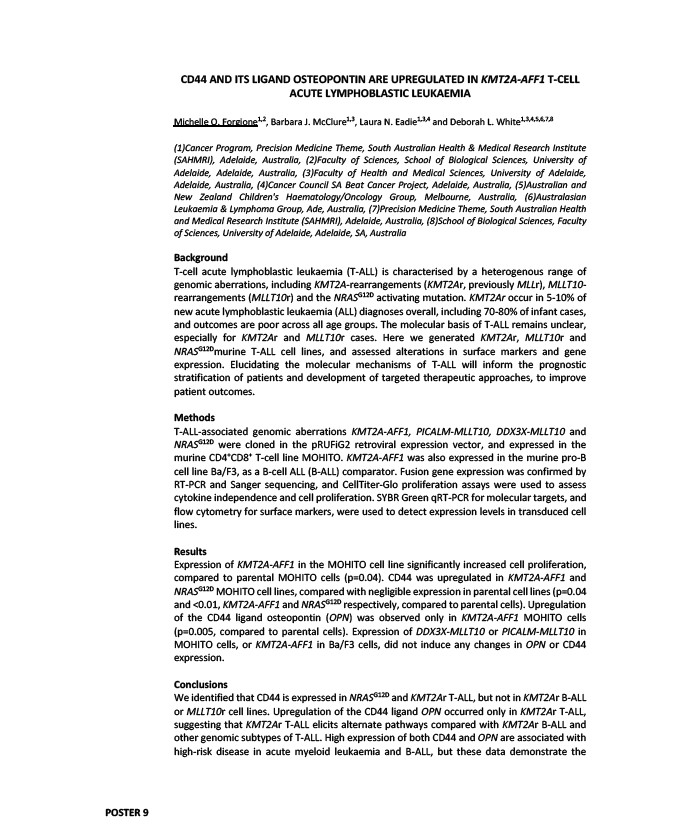
CD44 AND ITS LIGAND OSTEOPONTIN ARE UPREGULATED IN KMT2A-AFF1 T-CELL
ACUTE LYMPHOBLASTIC LEUKAEMIA
Michelle O. Forgione1,2, Barbara J. McClure1,3, Laura N. Eadie1,3,4 and Deborah L. White1,3,4,5,6,7,8
(1)Cancer Program, Precision Medicine Theme, South Australian Health & Medical Research Institute
(SAHMRI), Adelaide, Australia, (2)Faculty of Sciences, School of Biological Sciences, University of
Adelaide, Adelaide, Australia, (3)Faculty of Health and Medical Sciences, University of Adelaide,
Adelaide, Australia, (4)Cancer Council SA Beat Cancer Project, Adelaide, Australia, (5)Australian and
New Zealand Children's Haematology/Oncology Group, Melbourne, Australia, (6)Australasian
Leukaemia & Lymphoma Group, Ade, Australia, (7)Precision Medicine Theme, South Australian Health
and Medical Research Institute (SAHMRI), Adelaide, Australia, (8)School of Biological Sciences, Faculty
of Sciences, University of Adelaide, Adelaide, SA, Australia
Background
T-cell acute lymphoblastic leukaemia (T-ALL) is characterised by a heterogenous range of
genomic aberrations, including KMT2A-rearrangements (KMT2Ar, previously MLLr), MLLT10-
rearrangements (MLLT10r) and the NRASG12D activating mutation. KMT2Ar occur in 5-10% of
new acute lymphoblastic leukaemia (ALL) diagnoses overall, including 70-80% of infant cases,
and outcomes are poor across all age groups. The molecular basis of T-ALL remains unclear,
especially for KMT2Ar and MLLT10r cases. Here we generated KMT2Ar, MLLT10r and
NRASG12Dmurine T-ALL cell lines, and assessed alterations in surface markers and gene
expression. Elucidating the molecular mechanisms of T-ALL will inform the prognostic
stratification of patients and development of targeted therapeutic approaches, to improve
patient outcomes.
Methods
T-ALL-associated genomic aberrations KMT2A-AFF1, PICALM-MLLT10, DDX3X-MLLT10 and
NRASG12D were cloned in the pRUFiG2 retroviral expression vector, and expressed in the
murine CD4+CD8+ T-cell line MOHITO. KMT2A-AFF1 was also expressed in the murine pro-B
cell line Ba/F3, as a B-cell ALL (B-ALL) comparator. Fusion gene expression was confirmed by
RT-PCR and Sanger sequencing, and CellTiter-Glo proliferation assays were used to assess
cytokine independence and cell proliferation. SYBR Green qRT-PCR for molecular targets, and
flow cytometry for surface markers, were used to detect expression levels in transduced cell
lines.
Results
Expression of KMT2A-AFF1 in the MOHITO cell line significantly increased cell proliferation,
compared to parental MOHITO cells (p=0.04). CD44 was upregulated in KMT2A-AFF1 and
NRASG12D MOHITO cell lines, compared with negligible expression in parental cell lines (p=0.04
and <0.01, KMT2A-AFF1 and NRASG12D respectively, compared to parental cells). Upregulation
of the CD44 ligand osteopontin (OPN) was observed only in KMT2A-AFF1 MOHITO cells
(p=0.005, compared to parental cells). Expression of DDX3X-MLLT10 or PICALM-MLLT10 in
MOHITO cells, or KMT2A-AFF1 in Ba/F3 cells, did not induce any changes in OPN or CD44
expression.
Conclusions
We identified that CD44 is expressed in NRASG12D and KMT2Ar T-ALL, but not in KMT2Ar B-ALL
or MLLT10r cell lines. Upregulation of the CD44 ligand OPN occurred only in KMT2Ar T-ALL,
suggesting that KMT2Ar T-ALL elicits alternate pathways compared with KMT2Ar B-ALL and
other genomic subtypes of T-ALL. High expression of both CD44 and OPN are associated with
high-risk disease in acute myeloid leukaemia and B-ALL, but these data demonstrate the
POSTER 9